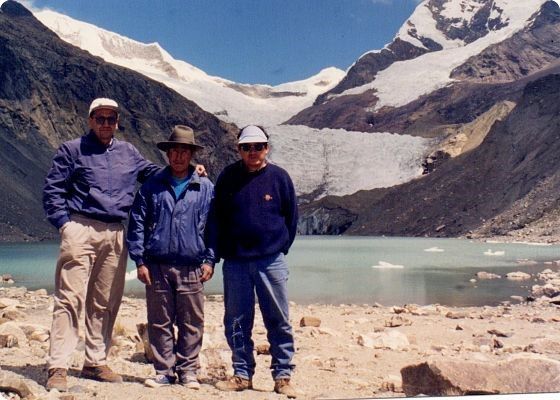Nepalese NGO Mountain Legacy has just announced that Peruvian engineer César Augusto Portocarrero Rodríguez will receive the Sir Edmund Hillary Mountain Legacy Medal in a public ceremony at Hotel Tibet International in Kathmandu on December 11 (International Mountain Day). César Portocarrero has directed projects to mitigate the danger of outburst floods from numerous glacial lakes in the Andes, saving thousands of lives and many millions of dollars, and he is now sharing his expertise with members of the High Mountain Adaptation Partnership (HiMAP), including Nepal, Bhutan, and several Central Asian nations
Nepalese NGO Mountain Legacy has just announced that Peruvian engineer César Augusto Portocarrero Rodríguez will receive the Sir Edmund Hillary Mountain Legacy Medal in a public ceremony at Hotel Tibet International in Kathmandu on December 11 (International Mountain Day). César Portocarrero has directed projects to mitigate the danger of outburst floods from numerous glacial lakes in the Andes, saving thousands of lives and many millions of dollars, and he is now sharing his expertise with members of the High Mountain Adaptation Partnership (HiMAP), including Nepal, Bhutan, and several Central Asian nations.
The Sir Edmund Hillary Mountain Legacy Medal is the world's most prestigious award for mountain advocacy. The Nepalese NGO Mountain Legacy was created in 2003 and authorized by Sir Edmund Hillary to administer the award, which is presented for remarkable service in the conservation of culture and nature in mountainous regions. The award is intended both to honor Sir Edmund's remarkable record of development assistance and also to encourage its emulation.
Commenting on the selection of Portocarrero, Mountain Legacy President Dr. Kumar P. Mainali (Dept. of Biology, University of Maryland) stressed the link between mountain recreation and development work:
“On May 29 sixty-three years ago, Edmund Hillary and Tenzing Norgay climbed the final steps that carried Colonel John Hunt's 1953 British Everest Expedition to a successful conclusion. For Edmund Hillary, however, the conquest of the so-called Third Pole was not so important as the love he discovered for the mountains and the people of Nepal. Applying the same energy, imagination, loyalty, and enthusiasm for the outdoors that had made him a great explorer and adventurer, Hillary now undertook to help his friends improve their lives and safeguard the legacies of their mountain environment and culture. Hillary remained an enthusiastic advocate of adventure as a means of opening the individual's spirit to unexpected challenges and opportunities. In a time of rapidly escalating challenges, we all need such adventurers, and we are quite fortunate to have César Portocarrero on our side.”
César Portocarrero received his degree in civil engineering from the National University of Cusco in 1971. On May 30, 1970, that region was struck by one of history's deadliest natural disasters. The 7.9 magnitude Ancash earthquake, provoked by the ongoing subduction of the Nazca plate beneath the South American plate, caused the collapse of the northern face of Nevado Huascarán. The avalanche, largest in recorded history, hydroplaned downhill at up to 300 km/hr, burying the towns of Yungay and Ranrahirca. Overall, the quake resulted in approximately 100,000 fatalities. Portocarrero immediately joined the reconstruction efforts, focusing on schools, sewers, and water distribution. In 1973 Portocarrero began to work on glaciology and lake security in the Huaraz region. Ever since the end of the Little Ice Age in the mid-nineteenth century, glacial regression has resulted in exponential growth of ice and moraine-dammed lakes, which are subject to catastrophic Glacial Lake Outburst Floods (GLOFs). As Director of the Institute of Glaciology and Water Resources, Portocarrero directed eighteen GLOF hazard mitigation projects.
Increased incidence of GLOFs is not the only risk posed by climate change. Receding glaciers endanger the water supply on which mountain communities and downstream urban areas depend. Portocarrero has therefore worked with stakeholders to design mitigation projects that not only reduce the levels of swelling lakes but create and manage reservoirs, irrigation, water distribution, and drainage so as to use resources prudently and equitably. The projects go far beyond infrastructure: for instance, regional stakeholders must be educated in the efficient use of water, which entails in-depth meteorological training.
Unfortunately, restricted funding has been a serious problem. For example, Lake Palcacocha, which broke out in 1941 and killed about 7000 citizens of Huaraz, is now thirty-five times larger than it was prior to that GLOF, and the existing reduction capability is conspicuously inadequate. "Neither national nor regional nor local government has shown a political willingness to support the installation of an early warning system that would save many lives in case Lake Placacocha breaks out again," observes Mr. Portocarrero. He has proposed a multi-pronged security project linked to improved water management that would assure a safer future for Peruvians and for all those who come to enjoy Huascarán National Park, a UNESCO World Heritage Site.
In addition to his work in Peru, César Portocarrero has been active in international scientific exchange programs, many of which have been supported by the US Agency for International Development (USAID), United Nations Development Program (UNDP), International Center for Integrated Mountain Development (ICIMOD), and The Mountain Institute (TMI).
For more information check the following links:
http://hillarymedal.org/medal2017.html


Contact Info: This email address is being protected from spambots. You need JavaScript enabled to view it.
Website : www.hillarymedal.com




